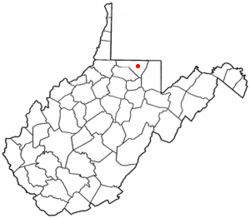Morgantown, West Virginia
| Morgantown, West Virginia | ||
|---|---|---|
| City | ||
| City of Morgantown | ||

Downtown Morgantown from Fife Avenue
|
||
|
||
| Motto: Regina Monongahelae — Vestigia Nulla Retrorsum | ||
 Location in Monongalia County in the State of West Virginia |
||
| Coordinates: 39°38′1″N 79°57′2″W / 39.63361°N 79.95056°WCoordinates: 39°38′1″N 79°57′2″W / 39.63361°N 79.95056°W | ||
| Country | United States | |
| State | West Virginia | |
| County | Monongalia | |
| Settled | 1772 | |
| Incorporated | 1838 | |
| Government | ||
| • Type | City Manager / Council | |
| • Mayor | Marti Shamberger | |
| • City Manager | Jeff Mikorski | |
| • City Council |
Council members
|
|
| Area | ||
| • City | 10.62 sq mi (27.51 km2) | |
| • Land | 10.17 sq mi (26.34 km2) | |
| • Water | 0.45 sq mi (1.17 km2) 4.24% | |
| Elevation | 960 ft (293 m) | |
| Population (2010) | ||
| • City | 29,660 | |
| • Estimate (2014) | 31,073 | |
| • Density | 2,916.4/sq mi (1,126.0/km2) | |
| • Urban | 70,350 (US: 393th) | |
| • Metro | 137,251 (US: 293th) | |
| Time zone | EST (UTC−5) | |
| • Summer (DST) | EDT (UTC−4) | |
| ZIP codes | 26501-26508 | |
| Area code | 304, 681 (effective March, 2009) | |
| FIPS code | 54-55756 | |
| GNIS feature ID | 1555161 | |
| Website | www.morgantownwv.gov | |
Morgantown is a city in and the county seat of Monongalia County, West Virginia, situated along the banks of the Monongahela River. With a permanent population of 31,073 per the 2015 U.S. Census estimates, Morgantown is the largest city in North-Central West Virginia. The Morgantown metropolitan area has a population of 138,176, and is the 3rd largest in West Virginia. West Virginia University adds several thousand seasonal residents to the city and surrounding area from September through May. Morgantown is best known as the home of West Virginia University and the Morgantown Personal Rapid Transit system.
Morgantown is closely tied to the Anglo-French struggle for this territory. Until the Treaty of Paris in 1763, what is now known as Morgantown was greatly contested by settlers and Native Americans, and by the British and the French. The treaty decided the issue in favor of the British, but Indian fighting continued almost to the beginning of the American Revolution.
Zackquill Morgan, son of Morgan Morgan, and his brother David entered the area of Virginia that would become Morgantown in about 1767, although others such as Thomas Decker are recorded as attempting settlements in the area earlier or at about the same time. As well, several forts were built in the area during this time: Fort Pierpont near the Cheat River, in 1769; Fort Coburn, near Dorsey's Knob, in 1770. Fort Morgan, at the present site of Morgantown, in 1772; Fort Dinwiddle, north several miles at Stewartstown, in 1772; Fort Martin, several miles north on the Monongahela River, in 1773; Fort Burris in the present-day Suncrest area of Morgantown, in 1774; and Fort Kern in the present-day Greenmont area of Morgantown, in 1774, in addition to other, smaller forts.
...
Wikipedia

